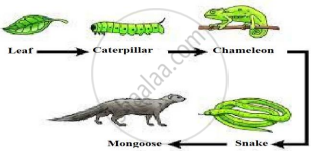Advertisements
Advertisements
प्रश्न
What is the percentage of photosynthetically active radiation (PAR), in the incident solar radiation?
पर्याय
100%
50%
1-5%
2-10%
उत्तर
50%
Explanation:
Less than 50 per cent of incident solar radiation is photosynthetically active radiation (PAR). Plants and photosynthetic bacteria (autotrophs) fix the Sun’s radiant energy to make food from simple inorganic materials. Plants capture only 2-10 per cent of the PAR, and this small amount of energy sustains the world.
APPEARS IN
संबंधित प्रश्न
Distinguish between Litter and detritus.
Define Diffusion
Explain why a progressive decline is seen in the population size from the first to the fourth trophic level in the above pyramid.
Correct and rewrite the following statement and justify your correction.
Plants in an ecosystem are called primary consumers.
State the law which governs the energy flow in an ecosystem.
The place of human being in food chain in an ecosystem is as
State two advantages and two limitations of Hydel Power.
Temperature, light and wind are ________ factors.
Trophic level in an ecosystem represents ______.
In the aquatic food chain, a major amount of energy flows through ______.
Name an organism found as secondary carnivore in an aquatic ecosystem.
Name an omnivore which occurs in both grazing food chain and the decomposer food chain.
What is the ultimate source of energy for the ecosystems?
Apart from plants and animals, microbes form a permanent biotic component in an ecosystem. While plants have been referred to as autotrophs and animals as heterotrophs, what are microbes referred to as? How do the microbes fulfil their energy requirements?
In relation to energy transfer in ecosystem, explain the statement "10 kg of deer's meat is equivalent to 1 kg of lion's flesh".
What will happen to an ecosystem if all producers are removed?
What will happen to an ecosystem if all organisms of herbivore level are eliminated?
Which of the following requires maximum energy?
Study the food chain given below and answer the question that follows:

If the amount of energy available at the third trophic level is 100 joules, then how much energy will be available at the producer level? Justify your answer.
